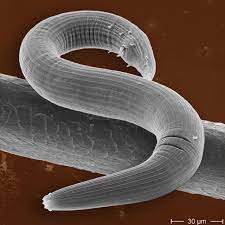Nematodes : New Species

Scientists at the University of California, Riverside have unveiled a new species of nematode, Steinernema adamsi, a minuscule yet potent ally in the battle against crop pests.
- Nematodes are any worm of the phylum Nematoda.
- Nematodes are among the most abundant animals on Earth.
- They occur as parasites in animals and plants or as free-living forms in soil, fresh water, marine environments, and even such unusual places as vinegar, beer malts, and water-filled cracks deep within Earth’s crust.
- Nematodes are bilaterally symmetrical, elongate, and usually tapered at both ends.
- Some species possess a pseudocoel, a fluid-filled body cavity between the digestive tract and the body wall.
- Nematodes have been reported from every continent on earth and occur in deserts, swamps, the oceans, the tropics and Antarctica.
- Nematode parasites of animals occur in almost all organs of the body, but the most common sites are in the alimentary, circulatory, and respiratory systems. Some of these worms are known by such common names as hookworm, lungworm, pinworm and threadworm
- They can cause a variety of diseases (such as filariasis, ascariasis, and trichinosis) and parasitize many crop plants and domesticated animals.
- Most nematodes feed on bacteria, fungi, or other microscopic creatures. As such, they are a major component of soil and sediment ecosystems.




